


Food products exported to target markets need to be labeled with product information in accordance with local food labeling regulations, which is an important aspect of compliance review before the products are marketed. In recent years, many companies have paid their attention to the Southeast Asian market, so the topic of labeling requirements for imported food in the Southeast Asian market has also received the attention of many exporters worldwide. This is the issue of the possibility of label co-edition design that Foodmate will discuss with you this time.
based on years of experience in label review and research findings on imported food regulations in the Southeast Asian markets, Foodmate believes that the main considerations for label co-edition design include language, labeling items, specific labeling format or form requirements, as well as the design size and overall planning of the artwork. These aspects determine whether a label can simultaneously meet the needs of different target markets. The following is an analysis using the Southeast Asian market as an example.
I. Language
Many Southeast Asian countries allow food labeling information in English, but there are some countries also have special requirements on labeling language. For example, food exported to Thailand can have English or other foreign language information on the label, but must have Thai labeling information; similarly, food exported to Vietnam must be labeled in Vietnamese; exported to Indonesia must be labeled in Indonesian, these countries basically can not share a set of labeling information with other target markets, but can co-exist.
At present, the Southeast Asian countries that allow product labeling information in English include Singapore, Malaysia, the Philippines, and Brunei; while other countries such as Thailand, Indonesia and Vietnam require labeling information in accordance with the specified language.
II. Labeling Items
In terms of labeling items, it is generally necessary to cover the mandatory labeling requirements of all target countries.
In Southeast Asian countries, the product name, ingredient list, net content, name and address of the importer or distributor, country of origin, date marking, etc. are items that must be declared on the imported food label. In addition, there will also be some other specific labeling requirements, such as Thailand requires the labeling of food serial numbers, Vietnam and Malaysia require the labeling of manufacturer information, and Indonesia requires the labeling of circulation license numbers, etc. Therefore, when exporting to countries that accept English labeling information, the most comprehensive information labeling (covering the mandatory labeling requirements of each country) can be used to design English label information.

III. Specific Labeling Format or Form Requirements
In this regard, it mainly involves specific labeling requirements for some specific labeling items. Here are a few more common examples for your reference.
(1) Allergens: Although there is little difference in food allergens in Southeast Asian countries, the labeling requirements are different in different countries for the presence of allergens in food, or the possible cross-contamination of allergens. For example, Singapore does not recommend using "May contain____" statement (not non-compliant, but even if so marked, when it comes to consumer complaints, the enterprise is not exempt from liability), but the Philippines, Malaysia, Thailand, Indonesia and other countries can accept such statement method.
(2)Food additives: In Southeast Asian countries that accept English labeling information, Malaysia accepts the labeling method of functional name+additive name or INS code; The Philippines requires the labeling of common names and functional category names for additives; Singapore accepts labeling only the name or INS code of food additives, or both can be labeled simultaneously; Brunei is the most unique in that as it requires a labeling form that includes allowed additives, followed by a parenthesis indicating the type and source of the additive. An example of the original text of the regulation is as follows:

(3) Date marking: Most Southeast Asian countries can accept date marking in the order of day, month and year, and also specify specific guiding words. Arabic numerals are also accepted for date marking, except for the Philippines. The Philippines also requires dates to be marked in the order of day, month, and year, but requires the months in the date markings to be indicated by words rather than numbers. For example, June 13, 2023 can be labeled as 13 Jun 2023/13 June 2023, or 13 Jun 23/13 June 23.
IV. Design Size & Overall Planning of the Artwork
If your minimum sales unit packaging area is not that large, and you also consider including some pictures and text and other promotional information, then you may not be able to design a large and comprehensive common version of the label for all Southeast Asian markets, you can design one label for some target markets (markets that accept English labels), and one or more labels for other languages. In fact, in terms of market acceptance and market development value, a product may not be exported to all countries in Southeast Asia at the same time, but only be exported to 3-4 countries in Southeast Asia, so it is possible to design a co-edition label that meets the food labeling requirements of all the target markets.
Of course, the design of food labels for export to the Southeast Asian market requires the participation of professionals with different technical backgrounds. In addition to marketing and design personnel, the effective gate-keeping of regulatory experts and even language experts is also indispensable, while the actual implementation of the date, batch number and other coding tasks of the production plant's full cooperation is required to ensure the final compliance of the common version of the label presentation.
V. Brief Summary
In general, the co-edition label design of food exported to the Southeast Asian market is theoretically feasible, and it needs to be designed according to the actual export planning of the enterprise. In the process, Foodmate can provide professional language and compliance guidance to add an additional layer of insurance to a company's food export compliance program.
Need help or have a question?
Send mail